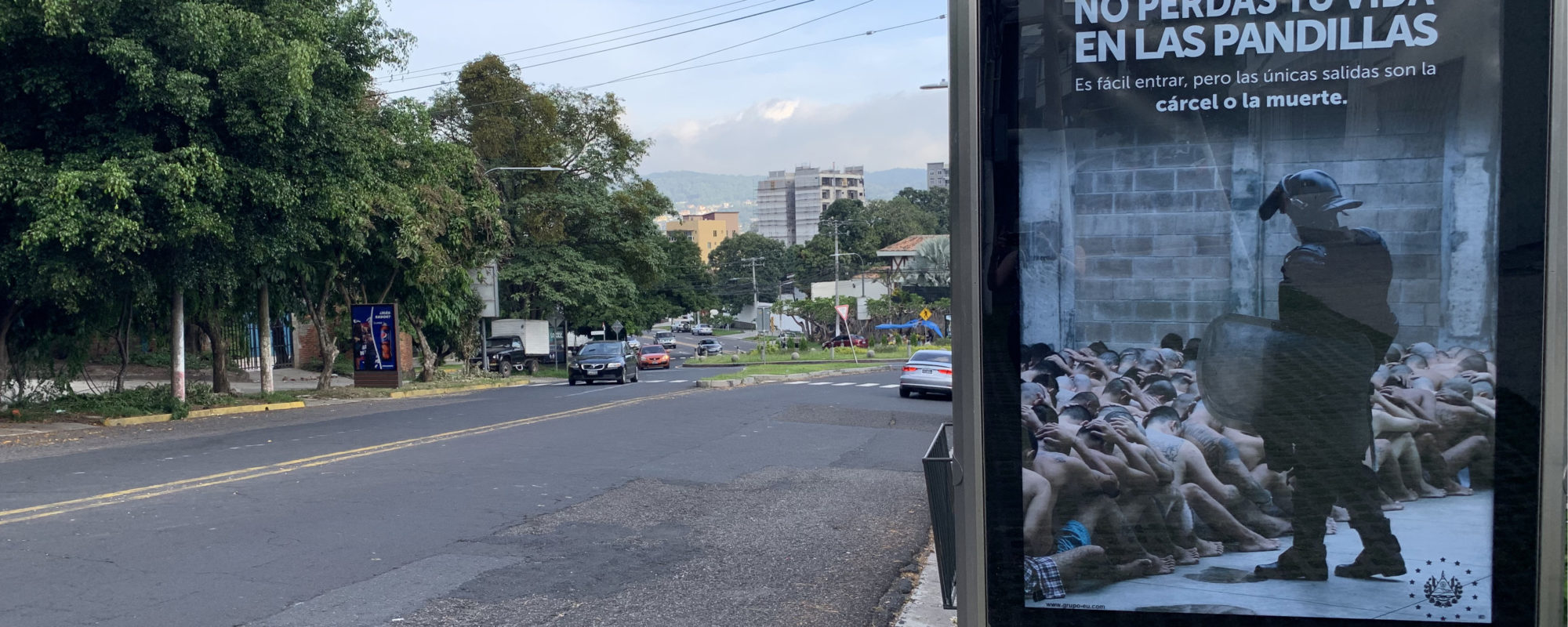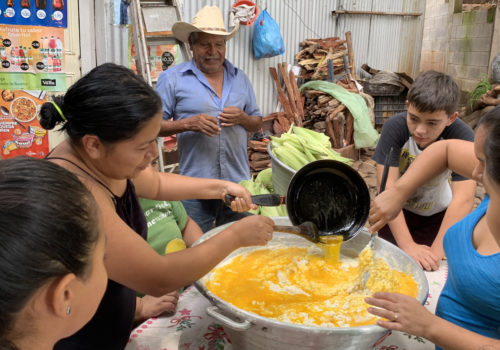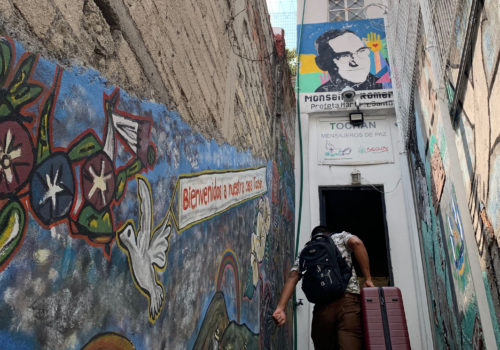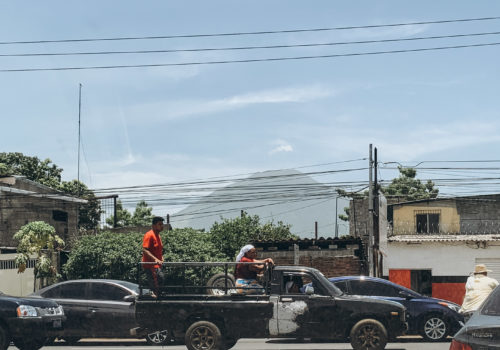SAN SALVADOR — Soldiers and heavily armed police officers are an almost daily sight in El Salvador. While stuck in traffic running errands in the city, I find myself next to a pickup truck whose bed is loaded with police officers carrying automatic rifles. Dropping a friend off in her village near the Honduran border in the north of the country, we are waved through a roadblock by a fresh-faced soldier in full combat gear. When I ask how she feels about soldiers in the middle of her town (destroyed and then rebuilt 30 years ago during the civil war), she shrugs. “They’re just doing their thing,” she says.
Since the signing of peace accords between the government and FMLN rebels in 1992, the homicide rate has skyrocketed and crime has become a constant topic of conversation among Salvadorans. Increased deportations from the United States in the mid-’90s coincided with the growth of street gangs, mainly the Mara Salvatrucha (MS-13) and Calle 18 (Eighteenth Street). But six months into President Nayib Bukele’s term and his new security plan, homicide numbers are now down and the US State Department has reduced the degree of alarm in its travel advisory to El Salvador.
Some of my friends, particularly those involved in the human rights community, say the differences are cosmetic and the current security plan is “more of the same.” Others seem optimistic about the changes, even as Salvadorans seem to keep leaving the country at the same high rates. I heard about a woman who presented herself at the US border and asked for asylum just for five years “because the new president is fixing things but it will take his whole term to get it done.” The woman had fled her home due to gang threats, one of the thousands of Salvadorans who continue to be displaced by violence.
President Bukele’s security plan, the Plan Control Territorial, kicked off with phase one: a massive deployment of the National Civil Police (PNC) and armed forces to “take back” territories controlled by street gangs. In mid-July, phase two launched the “positive” part of the plan, aimed at “repairing the social fabric,” creating new options and improving living conditions for at-risk youth. The presidency is currently seeking funding for phase three: the modernization of law enforcement.
I came to El Salvador partly to try to better understand the dangers faced by asylum-seekers and returnees, and document the failure and/or unwillingness of the state to protect its citizens. As I read the news each day, make plans with friends and go about my daily life, I have to ask myself: could it really be that things are getting better? If so, what does that mean for people like my former law practice clients—mostly migrants from Latin America—and the viability of their arguments to stay in the United States?
Homicide statistics don’t tell the whole story
Over the past few months, I have uncovered several reasons to doubt whether the number of officially reported homicides is a useful or accurate indicator of citizen safety. Not all violence is caused by the gangs, although you wouldn’t know it from the government’s security rhetoric. The Plan Control Territorial is specifically aimed at fighting street gangs and does not mention any other type of violence. On July 16, Bukele tweeted triumphantly, “This Monday, El Salvador only had one homicide and it is not related to gangs. It was a femicide of passion (definitely something we have to pay attention to). There is no doubt that the #territorialcontrol is working. I reiterate the call for all of us to support it.”
On a recent Friday morning, I visited a victims’ group that meets biweekly at a small hotel in downtown San Salvador. Participants told of violence and threats by gangs but also of losing family members to police violence or unexplained disappearances. I was asked to keep the specifics confidential, but the group members welcomed my presence and were eager to share their stories to help me understand what they were going through. Most of the conversation was about victims of human rights violations by the government, such as a young man caught in the crossfire of a shooting who had lain bleeding on the street because the EMTs and police officers who first arrived on the scene suspected he was a gang member. Many people wept openly throughout the conversation and laughed with relief as the facilitators led us in a silly group game to brighten the mood before lunch.
As we sat eating around a large table by the hotel pool, the conversation was light and centered around Salvadoran cuisine. What did I think of Salvadoran tortillas? Did I like pupusas? Did I know to eat them with my hands, not a knife and fork? As we laughed and joked, an older woman next to me pulled out her phone.
“Let me show you my son,” she said, showing me a sweet-faced kid with big ears and a shy smile. “This was taken a month before he died. He was outside playing and the police shot him. They said he was a gang member, but he wasn’t. He was 14 but he was delayed, he had the mind of maybe a 10-year-old.”
A curly-haired woman—with the kind of face that makes you think you know the person even if it’s the first time you’ve met—had already whipped out her own photographs and handed them across the table. “Here’s my daughter. Look, in this picture she is wearing the shirt she was wearing the day she disappeared. She was also 14.” The young girl in the snapshots looked a lot like her sister, a teenaged girl sitting next to her mom at the table, pushing food around on her plate.

“You know, I’m so sorry for you,” the first woman said. “I feel grateful that at least I know what happened to my son and we had his body to bury. I never thought about it at the time but now I thank God for that.”
“Yeah,” the second woman said without bitterness. “You are really lucky.”
If the government had its way, neither of those events would be recorded in the official homicide statistics. In July, the Bukele administration attempted to change the way official homicide statistics were reported. The government proposed to include only “social violence” but not the deaths of alleged gang members killed in confrontations with police (of which there had already been 35 in the administration’s first six weeks). Although the policy was later reversed, it also sent a message: Those accused of gang membership don’t count, and use of force against them by the police is presumed to be justified.
In August, the Human Rights Ombudsman published a report on extrajudicial executions attributed to the PNC between 2014 and 2018, showing that reports of unjustified killings by the PNC have significantly increased. The ombudsman’s investigation revealed that signs of torture and other injuries contradict the PNC’s official accounts of armed shootouts, and that there was evidence that in many cases the crime scene had been manipulated to cover up what had actually happened. Family members and witnesses reported being threatened by the police, and some families were displaced as a result. The Attorney General’s office, which did not cooperate with the ombudsman’s investigation and refused to share information from its files, was accused of negligence or complicity as most of the cases were not investigated or prosecuted.
The ombudsman’s report was consistent with the story of the woman who had lost her son. She said that after he was killed, more police arrived and said the incident had been a “confrontation,” an armed shootout, even though her neighbors who witnessed the event told her that her son had been playing alone and cried out “Don’t kill me!” before he was shot. Later that night, the PNC posted on social media that the confrontation had resulted in “another dead rat.” They showed up at her house calling it a gang safehouse, subjecting her and her family to questioning. The attorney general took the information, but archived the file without investigating further. One of the prosecutors warned her to move her other son away; he is now with her in-laws in a rural village and she hardly gets to see him.
The Bukele administration also sought to remove bodies found in clandestine mass graves from the homicide statistics. That raises the question of the “disappeared.” The Attorney General’s office published an official number of 3,437 reported disappearances in 2018, more than the total number of homicides, according to The Washington Post. That is widely seen as an undercount. Some of the disappeared later resurface in clandestine graves, and many others are never found.

Territorial control or territorial presence?
One of the frustrations of trying to understand gang activity in El Salvador is its localized nature. The neighborhoods where gang presence is most notable—and most of the violence occurs—are away from the main streets and unwelcoming to outsiders. It is inadvisable to visit those neighborhoods without an escort, and even during visits, gang activity is not easily visible to someone who doesn’t know what to look for. Soldiers and heavily armed police officers are much more evident to an outsider like me.
After my car overheated on a drive back from Chalatenango, I had the good fortune to get to know Alexander (not his real name), a rehabilitated former gang leader and activist. I first met him in 2017, when he gave a presentation on gang hierarchy at a training course I helped organize for asylum lawyers. When he heard I was having trouble, he immediately offered to help me navigate the unfamiliar world of Salvadoran mechanics. While driving me around town and helping me seek second, third and fourth opinions about the state of my car, he also spoke freely about his time in the gang and his decision to leave, and answered my questions.
When I asked him if he thought the Plan Control Territorial was working, he replied, “The government doesn’t have territorial control. They have territorial presence.” He went on to explain that, as far as he knows, other criminal activities by gangs (such as extortion) have not diminished, but that the gangs’ leaders simply ordered fewer killings to try to obtain better prison conditions and draw less attention to their activities. The gangs still control their territory, he explained, particularly in communities like his. As we drove around the city, he often pointed out the dividing lines between territories and made accommodations based on where he could safely go. (We met one of his mechanic friends, Josue, on a main street to drop off my car, for example; Josue’s shop is in rival gang territory, so it’s not safe for Alexander to go there.)
A visit to Alexander’s neighborhood north of San Salvador’s university district illustrated his point. Before we even reached the intersection, he told me we would see soldiers posted outside the neighborhood’s entrance, and, sure enough, there they were on the corner, looking very young under their full combat gear. We passed them and went through the gate, entering a vast walled community where the main drag was lined with the entrances to smaller alleys or pasajes, many of them with an armed security guard out front. Our windows were rolled partway down, so they could see who we were.
Alexander explained that rather than working to protect community members from the gang, the security guards were on the gang’s payroll and would alert its members about anyone entering their turf. Indeed, it was safe to assume anyone we saw outside was acting as some kind of lookout. “First, you have to understand whose territory you’re in, who is in charge,” he said. “Everyone plays a role. They are operating at the pleasure of the gang.” We hadn’t gone more than half a mile before he added, “They already know we’re here. If they didn’t know me, we would have already been stopped by now and asked for our papers.”
“So do the soldiers always stay outside the community?” I asked. Alexander shook his head.

“No, sometimes they come in, and if they see a bicho (young man), they’ll probably kill him. But if the lookouts do their job, nobody will be out on the street by the time they get there. And if the lookouts don’t get a warning out, that will be trouble for them!”
We drove deeper into the community, which was quite large: more like a village than a neighborhood. Several of the pasajes had clusters of young men hanging around their entrances, and Alexander pointed out a young man leaving a corner store with a bottle of soda. He asked me to notice how long it had taken us to drive this far into the neighborhood, and I could see how the gang members would be tipped off with enough time to hide if the lookouts near the entrance did their jobs right.
“What about other kinds of crime?” I asked. “For example, if a woman is suffering domestic violence, what happens if she calls the police?”
“The gang wouldn’t let that happen. If they hear about it, the guy would get a knock on the door telling him to cut it out. There’s no crime here. They’ll punish anyone who could bring the attention of the police: a bolo (drunk), an abuser. Living here means living by the rules.”
Don’t lose your life
“Don’t lose your life in the gangs,” flashed an electronic billboard. “It’s easy to enter, but the only exits are prison or death.” The words disappeared, replaced by a photograph of rows of men, some with tattoos, dressed only in boxer shorts, their heads shaved and bowed, crowded together in faceless rows. Before I could fully register what I had just seen, the image disappeared and was replaced by an ad for a local seafood restaurant. It was a Sunday morning in mid-July and I was driving down 49th Avenue South, one of San Salvador’s main thoroughfares, on my way home from church.
Soon, I started seeing such images nearly every day. Billboards and digital advertising screens are ubiquitous; whatever restrictions protect scenic drives in the United States from such eyesores are either not present or not enforced here. They usually advertise auto parts, fast food restaurants, blockbuster movies, banks—so the anti-gang messages stood out. Although the language seemed to speak directly (and in the informal vos verb tense) to young people at risk of gang recruitment, many of the signs I saw were situated in places where (it seemed to me) such youths would be unlikely to see them or at least to be the primary audience.
Seeing graphic images of prisoners on billboards ‘makes people angry at the state, and more identified with the gang. To stop people from joining gangs, you have to give them an alternative community to identify with. Those billboards are just meant to make people afraid and feed their morbid fascination with the gangs.’
Driving down Boulevard Los Próceres, another main road, I saw a billboard over a pharmacy showing an officer in riot gear looming over rows of detainees. In the upscale San Benito neighborhood, where I often visit to attend yoga classes or the art museum, or forums at the Sheraton Presidente conference center, I spotted at least four different signs within a few blocks of each other: a flashing screen on the corner by the CIFCO convention center (across from the David J. Guzmán Anthropology Museum), and three standalone publicity boards on various street corners including on a curb outside a luxury boutique. The incongruous image leapt out from a row of uniform terracotta gated communities in fancy Santa Elena, near the US Embassy and the prestigious American School. Yet when I ventured into poorer neighborhoods where gangs were likely present, in nearby Soyapango and Ciudad Delgado, the images were absent.
In the bottom corner of some of the billboards, I noticed the coat of arms of President Bukele’s administration. (As president-elect, Bukele controversially added a ring of stars around the national coat of arms, and has continued using that image on official correspondence since taking office.) There was also a link to a website: www.grupo-eu.com. When I tried to visit it, the domain name was listed as “for sale.” A public records request confirmed that the publicity campaign had been authorized by the presidency, “to make known to the general population, Phase Two of the Territorial Control Plan.”
“Phase two” of the plan was supposed to be the “positive” stage, as I’ve mentioned. It was hard for me to understand how the display of stigmatizing images of prisoners would help to repair the social fabric, however. The language of the publicity explicitly omitted any possibility of rehabilitation or reinsertion of gang members or convicted criminals. The message seemed clear: all gang members are dangerous criminals who deserve to be dehumanized and locked away. The images seemed designed to shore up political support. “The likelihood that the public will support punitive measures is heightened when news items incorporate stereotypically alarming photos that emphasize the ‘otherness’ of the gang members,” one expert, Sonya Wolf, writes in her book Mano Dura.
But for those with family members in prison, the images are deeply painful. Alexander told me about his brother, who finished a 19-year prison term in January but was sentenced to another 14-year term after the breakdown of the “truce” between the government and gangs in 2015. He said their mother despairs of living long enough to see her son and worries about him all the time. Due to extraordinary measures in the prisons, inmates are not allowed to have any contact with their families. It is widely reported that prison healthcare is inadequate and tuberculosis outbreaks frequent. Alexander described searching the images closely when he first saw them, trying to see if he recognized anyone.
I asked him if he thought the billboards would deter any potential gang members and he shook his head and laughed ironically. “Of course not! You have to understand that gangs are antisocial, but people identify with them. So the billboards are like a declaration of war.”
“Everyone who joins a gang knows that death or prison are the likely outcomes, but to die for your brothers is a badge of honor,” Alexander added. “Seeing those images makes people angry at the state, and more identified with the gang. To stop people from joining gangs, you have to give them an alternative community to identify with. Those billboards are just meant to make people afraid and feed their morbid fascination with the gangs.”

Most of my Salvadoran friends take regular routes between home and work, without venturing into unknown places. Although talking with taxi drivers is a tired cliché, every time I travel by Uber, I am eager to hear the driver’s perspective. Unlike taxi drivers, Uber drivers usually have another job outside transportation, but they also have greater mobility than many people as they crisscross the city. (Despite this greater mobility, drivers almost always ask for the destination via text prior to accepting a fare, to ensure that the passenger isn’t heading to dangerous territory.)
A driver named Elmer, with a round, dimpled face and slicked back hair, told me he lives in a dangerous, gang-controlled neighborhood in a suburb north of San Salvador, and that there have been soldiers present in his neighborhood starting early in the morning each day. He has noticed that people in his community are staying out a little later in the evenings and the gang members have been gone from the streets. That makes him tentatively optimistic about the success of the Plan Control Territorial, although he conceded it’s unclear where the gang members have gone and whether they will be back once the police and soldiers reduce their presence.
He showed me pictures of his young children on his phone, and I asked how he felt about them seeing disturbing images like the image on the billboard. “Living in El Salvador, children see many disturbing things,” he said. “I remember when I was a child, watching as gang members on the street in front of my house beat a man and dropped a brick on his face. It’s good for children to see those pictures even if they are disturbing, so that they can make better decisions.”
Seeking a solution that will endure
Thousands of Salvadorans continue to leave the country to seek asylum in the United States and elsewhere. They must prove that their government is either the agent of persecution or unwilling or unable to control their persecutors. The deployment of soldiers and additional police officers seems to enjoy broad support among large segments of the population, but the evidence of its success is still ambiguous.
Violence by state actors acting with impunity against members of at-risk communities has been well documented and not meaningfully addressed by the current administration. Moreover, an overall decline in the homicide rate doesn’t take into account other forms of violence or the worrisome levels of disappearances. The presence of soldiers and police officers on the streets may have driven gang activity out of sight but has not addressed the root causes of gang violence. Further demonizing gang members through divisive propaganda may be politically savvy but it also sends a troubling message.
As the Plan Control Territorial moves into phase three, the government will have the opportunity to show whether it can build on the gains of the last six months to create a lasting improvement in the lives of at-risk Salvadorans, including members of undesirable communities such as those with gang ties. In the meantime, for many people facing threats from gangs, the police and others, seeking asylum elsewhere will still be the safest option.




